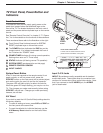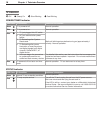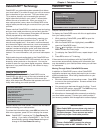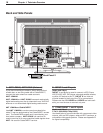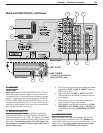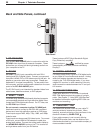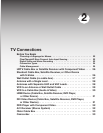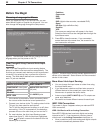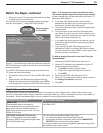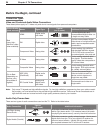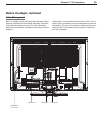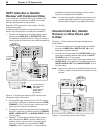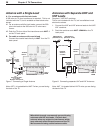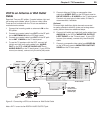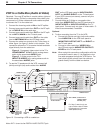
Chapter 2. TV Connections 23
• Allow you to use a TV menu to select either the analog
or digital output from the device.
For instructions on switching between analog and digital
outputs, see chapter 7, “Using IEEE 1394 Devices.”
Name assigned
to the device
Figure 3. The ClearThought Auto Input Sensing screen for
IEEE 1394 devices includes a check box for an associated
analog connection.
If your IEEE 1394 device has an analog connection to the
TV, follow the instructions below.
1. Connect the device to the TV with an IEEE 1394 cable
first.
2.
When the New 1394 Device screen appears with the
Analog Connection check box highlighted, press
ENTER
to
enter a check mark. See figure 3, New 1394 Device screen.
Digital Video and Home Recording
The table below will help you decide which type of connection to use for digital video. Digital video comes to your
home in a compressed state, whether received on recorded media (e.g., disc) or broadcast over the air, over cable, or
via satellite. Some compressed digital video is available for recording as noted in the table.
Connection Type into the TV
Effect on Home Recording
HDMI or DVI
Compressed video is converted to
uncompressed form by an external device
such as a cable box, satellite receiver, or
DVD player before it is sent to the TV on an
HDMI or DVI cable.
You cannot record the resultant uncompressed video sent to the TV
via HDMI or DVI.
IEEE 1394 (FireWire®) Connections
Your TV can receive and decode digital
channels, MPEG2 compressed digital video,
and Dolby Digital audio.
You can record compressed digital video either
• on compatible digital recorders as digital signals
• as standard-definition composite video from the
MONITOR
OUTPUT
jack converted to analog signals
You may be unable to record some programming because of copy restric-
tions added by the content owners.
Note: It is important to check mark the box when
this screen appears upon first connecting the device,
as later changes can only be made after returning all TV
settings to their defaults.
3. In the New 1394 Device screen, note the name
assigned to the device, as you will need to use the
same name in a later step. See figure 3.
4. Connect the device to the TV with the supplemental
analog cables.
5. The next screen is the Auto Input Sensing screen
(see figure 2) in which you can select a name for the
device. Select the same name you noted in the New
1394 Device screen (see figure 3).
• If you select the wrong name for the device, you will
be unable to switch between the analog and digital
inputs to the TV.
• If you connect an IEEE 1394 cable box and it is
detected as CABLE in the New 1394 Device screen,
be sure to select the name CABLE as the name for the
analog input and not cablebox.
To Add an Analog Connection at a Later Time (not
recommended)
1. Disconnect the IEEE 1394 device from the TV.
2. Reset all TV settings to their defaults using the TV
Reset service menu as follows:
a. Press
MENU
to display the Main menu.
b. Press
1 2 3
to open the Reset service menu.
c. Press
ENTER
.
3. Reconnect the IEEE 1394 device to the TV.
4. When the TV recognizes the device, place a check in
the Analog Connection check box.
5. Press
EXIT
.
Before You Begin, continued



